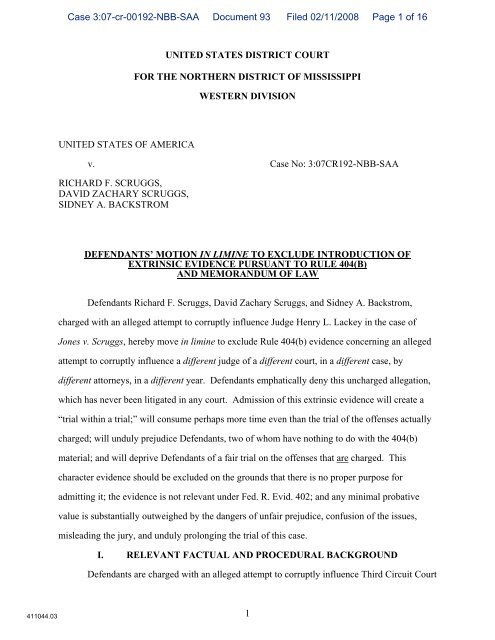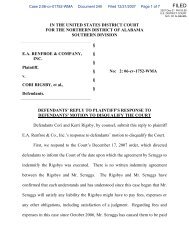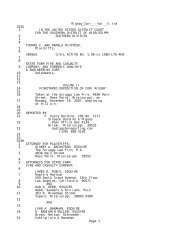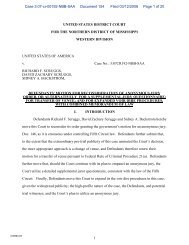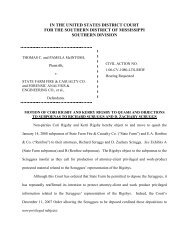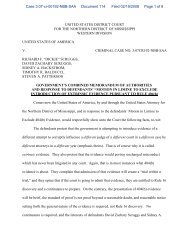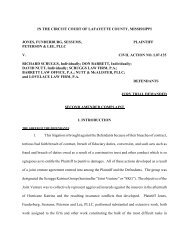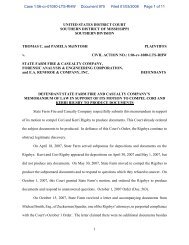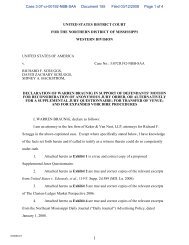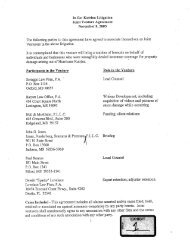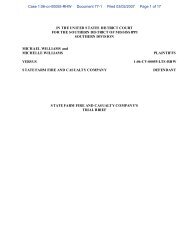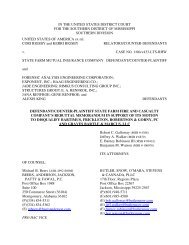Motion to Exclude 404b Testimony - Yall Politics
Motion to Exclude 404b Testimony - Yall Politics
Motion to Exclude 404b Testimony - Yall Politics
Create successful ePaper yourself
Turn your PDF publications into a flip-book with our unique Google optimized e-Paper software.
Case 3:07-cr-00192-NBB-SAA Document 93 Filed 02/11/2008 Page 1 of 16UNITED STATES DISTRICT COURTFOR THE NORTHERN DISTRICT OF MISSISSIPPIWESTERN DIVISIONUNITED STATES OF AMERICAv.Case No: 3:07CR192-NBB-SAARICHARD F. SCRUGGS,DAVID ZACHARY SCRUGGS,SIDNEY A. BACKSTROMDEFENDANTS’ MOTION IN LIMINE TO EXCLUDE INTRODUCTION OFEXTRINSIC EVIDENCE PURSUANT TO RULE 404(B)AND MEMORANDUM OF LAWDefendants Richard F. Scruggs, David Zachary Scruggs, and Sidney A. Backstrom,charged with an alleged attempt <strong>to</strong> corruptly influence Judge Henry L. Lackey in the case ofJones v. Scruggs, hereby move in limine <strong>to</strong> exclude Rule 404(b) evidence concerning an allegedattempt <strong>to</strong> corruptly influence a different judge of a different court, in a different case, bydifferent at<strong>to</strong>rneys, in a different year. Defendants emphatically deny this uncharged allegation,which has never been litigated in any court. Admission of this extrinsic evidence will create a“trial within a trial;” will consume perhaps more time even than the trial of the offenses actuallycharged; will unduly prejudice Defendants, two of whom have nothing <strong>to</strong> do with the 404(b)material; and will deprive Defendants of a fair trial on the offenses that are charged. Thischaracter evidence should be excluded on the grounds that there is no proper purpose foradmitting it; the evidence is not relevant under Fed. R. Evid. 402; and any minimal probativevalue is substantially outweighed by the dangers of unfair prejudice, confusion of the issues,misleading the jury, and unduly prolonging the trial of this case.I. RELEVANT FACTUAL AND PROCEDURAL BACKGROUNDDefendants are charged with an alleged attempt <strong>to</strong> corruptly influence Third Circuit Court411044.031
Case 3:07-cr-00192-NBB-SAA Document 93 Filed 02/11/2008 Page 2 of 16District Judge Henry L. Lackey in 2007 in connection with a fee dispute then pending beforehim, Jones, et al. v. Scruggs, et al. The indictment in this case alleges that Tim Balducci (i) inthe Spring of 2007 made an “overture” <strong>to</strong> his longtime friend and men<strong>to</strong>r Judge Lackey <strong>to</strong> decidethe case favorably <strong>to</strong> the Jones defendants; (ii) in the fall of 2007, agreed <strong>to</strong> Judge Lackey’sdemand for a $40,000 payment; and (iii) obtained Defendants’ ratification of that payment andparticipated with them in the cover up of that payment through false documentation of legalwork in yet another case.On January 28, 2008, the government filed a notice of its intent <strong>to</strong> introduce “other act”evidence pursuant <strong>to</strong> Rule 404(b), identifying the evidence in a subsequent letter <strong>to</strong> Defendants’counsel as “another attempt <strong>to</strong> corruptly influence a judicial proceeding,” referring <strong>to</strong> a searchwarrant application for the Langs<strong>to</strong>n Law Firm and the information, factual basis, and pleacolloquy in United States v. Joseph C. Langs<strong>to</strong>n, Case No. 1:08CR003. 1On January 7, 2008, former at<strong>to</strong>rney Joseph C. Langs<strong>to</strong>n pled guilty <strong>to</strong> a one-countinformation charging him with conspiring <strong>to</strong> attempt in 2006 <strong>to</strong> corruptly influence First CircuitCourt District Judge Bobby DeLaughter in a case then pending before Judge DeLaughter, Wilsonv. Scruggs. See Ex. A.As the Wilson facts are alleged by the government, Richard Scruggs hired the Langs<strong>to</strong>nLaw Firm <strong>to</strong> represent Scruggs in the Wilson case, a fee dispute case involving asbes<strong>to</strong>slitigation, which was litigated in various courts for approximately ten years. 2At some point wellafter Langs<strong>to</strong>n began representing Scruggs in the Wilson dispute, Langs<strong>to</strong>n, according <strong>to</strong> thegovernment’s proffer, retained and paid at<strong>to</strong>rney Ed Peters <strong>to</strong> provide advice and consultation onthe strategy for the Wilson case. See Ex. C at 17. The government has not alleged that theDefendants in this case had anything <strong>to</strong> do with Langs<strong>to</strong>n’s hiring Peters for the purpose of1 All Exhibits (“Ex.”) cited herein are exhibits <strong>to</strong> the Declaration of Brook Dooley filed herewith.2 The Wilson dispute spanned a decade and different aspects of that dispute were litigated invarious federal and state courts. Although the government is correct that Langs<strong>to</strong>n and Balduccifirst entered formal appearances in the Hinds County case in January 2006, Langs<strong>to</strong>n andBalducci already had been working on the Wilson dispute for at least two years by then, and werecounsel of record in the federal action, Wilson v. Scruggs, 3:02CV525LN (S.D. Miss.).According <strong>to</strong> the federal docket for the Wilson dispute, Langs<strong>to</strong>n and Balducci enteredappearances on behalf of Richard Scruggs on January 6, 2004. See Ex. B.411044.032
Case 3:07-cr-00192-NBB-SAA Document 93 Filed 02/11/2008 Page 3 of 16corruptly influencing Judge DeLaughter or for any other purpose. To the contrary, SpecialAgent John Quaka’s affidavit supporting the Langs<strong>to</strong>n search warrant states that Richard Scruggsexpressly instructed Langs<strong>to</strong>n <strong>to</strong> make sure that he did not do anything improper. See Affidavi<strong>to</strong>f John Quaka, Dec. 9, 2007, 27 (“‘[L]et’s just make sure we keep our skirts clean on this.’”). 3The government claims that “[Richard] Scruggs <strong>to</strong>ld Langs<strong>to</strong>n <strong>to</strong> let [Judge DeLaughter]know that if he ruled in [Scruggs’] favor, [Scruggs] would pass [Judge DeLaughter’s] namealong for consideration regarding [a] federal judgeship . . .” and “in fact DeLaughter’s name wassubmitted for consideration for a federal judgeship.” Ex. C at 17-18. The government’s theory issomewhat muddled since only the President appoints federal judges, and there is no claim thatJudge DeLaughter’s name was ever submitted <strong>to</strong> the President. In any event, the Wilsonallegations are quite different from the cash-bribe allegations in this case.II.ARGUMENTThe Court should not permit the introduction of Rule 404(b) evidence arising from thealleged Wilson/DeLaughter allegations. The Fifth Circuit recognizes “a cardinal principle of thecommon law that evidence of the commission of a wholly separate and independent crime isinadmissible as part of the case against the defendant. The reason for this rule is, of course, thatthe guilt or innocence of the accused should be established by the evidence relevant <strong>to</strong> thealleged offense being tried, not because the jury may believe the defendant <strong>to</strong> be a person of badcharacter or because he committed a similar offense.” United States v. Taglione, 546 F.2d 194,199 (5th Cir. 1977) (citing Michelson v. United States, 335 U.S. 469, 475-76 (1948)). Thus,there is a presumption that extrinsic evidence “of a wholly separate and independent crime isinadmissible as part of the case against the defendant.” Taglione, 546 F.2d at 199.Fed. R. Evid. 404(b) codifies this common law principle, recognizing only limited“carved out” exceptions. Id. Specifically, Rule 404(b) provides:Evidence of other crimes, wrongs, or acts, is not admissible <strong>to</strong> prove the characterof a person in order <strong>to</strong> show action in conformity therewith. It may, however, beadmissible for other purposes, such as proof of motive, opportunity, intent,preparation, plan, knowledge, identity, or absence of mistake or accident . . . .3 Defendants respectfully request that the Court take judicial notice of this quotation fromSpecial Agent Quaka’s affidavit.411044.033
Case 3:07-cr-00192-NBB-SAA Document 93 Filed 02/11/2008 Page 4 of 16Before evidence of other crimes, wrongs, or acts may be admitted by a Court pursuant <strong>to</strong> Rule404(b): (1) the evidence must have a proper purpose under Fed. R. Evid. 404(b), that is it mustbe relevant <strong>to</strong> an issue other than the character of Defendants (e.g., identity, knowledge, or plan);(2) it must be relevant under Fed. R. Evid. 402; (3) its probative value must not be substantiallyoutweighed by the dangers of unfair prejudice, confusion of the issues, or misleading material;and (4) the Court must charge the jury <strong>to</strong> consider the evidence only for the limited purpose forwhich it is admitted. See Huddels<strong>to</strong>n v. United States, 485 U.S. 681 (1988); see also UnitedStates v. Griffin, 324 F.3d 330, 360 (5th Cir. 2003) (as amended). Further, the Court should statespecifically, prior <strong>to</strong> its decision <strong>to</strong> admit Rule 404(b) evidence, the purpose for which it isadmitting the evidence. See United States v. Youts, 229 F.3d 1312 (10th Cir. 2000).A. The only conceivable purpose for admitting the Wilson/DeLaughter extrinsicevidence pursuant <strong>to</strong> Rule 404(b) is the forbidden purpose: <strong>to</strong> suggestDefendants’ bad character.The government cannot be permitted <strong>to</strong> introduce extrinsic evidence related <strong>to</strong> the Wilsoncase <strong>to</strong> prove that Defendants have a propensity <strong>to</strong> “attempt <strong>to</strong> corruptly influence a judicialproceeding” in violation of 18 U.S.C. § 666. Rule 404(b) precludes the introduction of evidenceof uncharged wrongful acts <strong>to</strong> prove the character of a person “in order <strong>to</strong> show action inconformity therewith”, i.e., <strong>to</strong> suggest an individual’s propensity <strong>to</strong> engage in certain criminalconduct. See Old Chief v. United States, 519 U.S. 172, 181-82 (1997); United States v.Ridlehuber, 11 F.3d 516, 521 (5th Cir. 1993). Rule 404(b) “follows the venerable principle thatevidence of extrinsic offenses should not be admitted solely <strong>to</strong> demonstrate the defendant’s badcharacter,” even when the extrinsic evidence is relevant, because such evidence is inherentlyprejudicial. United States v. Beechum, 582 F.2d 898, 910 (5th Cir. 1978) (en banc).Here, the only conceivable purpose for admitting extrinsic evidence related <strong>to</strong> the Wilsoncase would be for the government <strong>to</strong> suggest Defendants’ propensity <strong>to</strong> attempt <strong>to</strong> corruptlyinfluence judicial proceedings -- that Defendants, having previously engaged in similar conduct,are the type of people who attempt <strong>to</strong> corruptly influence judicial proceedings. The introductionof this extrinsic evidence does not help the government prove any element or consequential factsin this case. It should be excluded.411044.034
Case 3:07-cr-00192-NBB-SAA Document 93 Filed 02/11/2008 Page 5 of 16B. There is no permissible purpose for admitting the Wilson/DeLaughterextrinsic evidence pursuant <strong>to</strong> the exceptions carved out in Rule 404(b).Nor is the Wilson evidence admissible for one of the proper “other purposes”contemplated by the carefully carved-out exceptions <strong>to</strong> Rule 404(b), “such as proof of motive,opportunity, intent, preparation, plan, knowledge, identity, or absence of mistake or accident.”Fed. R. Evid. 404(b). When considering whether <strong>to</strong> permit the introduction of extrinsic evidenceof similar acts pursuant <strong>to</strong> Rule 404(b), the Fifth Circuit has advised district courts “that thevarious categories of [Rule 404(b)] exceptions -- intent, design or plan, identity, etc. -- are notmagic passwords whose mere incantation will open wide the courtroom doors <strong>to</strong> whateverevidence may be offered in their names. To the contrary, each exception has been carefullycarved out of the general rule <strong>to</strong> serve a limited judicial and prosecu<strong>to</strong>rial purpose.” UnitedStates v. Goodwin, 492 F.2d 1141, 1155 (5th Cir. 1974) (emphasis added). Here, the governmentcannot establish that its introduction of the Wilson/DeLaughter extrinsic evidence would bepermitted by one of the “carefully carved” Rule 404(b) exceptions <strong>to</strong> the general rule thatevidence of a wholly separate and independent crime is inadmissible. Id.1. Motive and opportunity.Rule 404(b) permits the introduction of extrinsic evidence of similar acts where themotive for the charged crime can be proved by prior or subsequent crimes, wrongs, or acts. SeeUnited States v. Cook, 592 F.2d 877 (5th Cir.), cert. denied, 422 U.S. 921 (1979). No reasonablejuror could conclude that Defendants’ motive or opportunity in allegedly ratifying Balducci’sagreement <strong>to</strong> Judge Lackey’s demand for $40,000 resulted from, or was otherwise connected <strong>to</strong>,an alleged non-monetary offer <strong>to</strong> Judge DeLaughter, a year earlier, that he could be consideredfor nomination as a federal judge. The Jones and Wilson cases have nothing <strong>to</strong> do with eachother.2. Criminal intent, knowledge, absence of mistake, or accident.Nor may the Wilson evidence be offered for the purpose of establishing criminal intent,knowledge, absence of mistake, or accident 4 because the acts of the Defendants that are alleged4 Because each of these “other purposes” goes <strong>to</strong> a defendant’s mens rea, they are all discussed411044.035
Case 3:07-cr-00192-NBB-SAA Document 93 Filed 02/11/2008 Page 6 of 16in this case and in the Wilson case are not sufficiently similar for a reasonable juror <strong>to</strong> concludeby a preponderance of the evidence that the Wilson extrinsic evidence is probative of any ofthese 404(b) bases for admission. See Huddles<strong>to</strong>n, 485 U.S. at 690 (defining applicable standardas “whether the jury could reasonably find the conditional fact . . . by a preponderance of theevidence.”). For extrinsic evidence of intent <strong>to</strong> be admitted, that evidence must allow areasonable juror <strong>to</strong> conclude that Defendants’ intent <strong>to</strong> commit the charged offenses in this caseis more probable as the result of the admission of evidence of the alleged extrinsic offense. Seeid.; Fed. R. Evid. 401 & 402.The differences between the extrinsic offense alleged in the Wilson case and the offensesthe government must prove in this case are such that no reasonable juror could conclude that theWilson evidence has a tendency <strong>to</strong> help prove the element of specific intent required in this case.Among the differences between this indictment and the alleged uncharged extrinsic offense are(i) the nature of the alleged bribes, (ii) the Defendants alleged <strong>to</strong> be involved (there is noallegation that Zach Scruggs and Sid Backstrom are involved in the DeLaughter situation), and(iii) the witnesses alleged <strong>to</strong> be involved: at<strong>to</strong>rneys Joey Langs<strong>to</strong>n and Ed Peters, JudgeDeLaughter, and members of the United States Senate and their staff who are involved in therecommendation and nomination process for federal judges, have nothing <strong>to</strong> do with this case.Given these and other substantial differences between the allegations in this case and theuncharged conduct in the Wilson case, it would be unreasonable for any juror <strong>to</strong> conclude fromevidence relating <strong>to</strong> the Wilson case anything about Defendants’ specific intent <strong>to</strong> conspire orattempt <strong>to</strong> influence Judge Lackey in this case. That Richard Scruggs allegedly <strong>to</strong>ld at<strong>to</strong>rneyLangs<strong>to</strong>n <strong>to</strong> tell at<strong>to</strong>rney Peters <strong>to</strong> tell Judge DeLaughter that Scruggs would recommend JudgeDeLaughter <strong>to</strong> be considered for a federal judgeship is not probative of whether RichardScruggs, Zach Scruggs, and Sid Backstrom had the intent <strong>to</strong> conspire and attempt <strong>to</strong> pay money<strong>to</strong> Judge Lackey, after Judge Lackey requested the payments and after the payments <strong>to</strong> JudgeLackey had been made. The evidence should be excluded. See Huddles<strong>to</strong>n, 485 U.S. at 689-90.herein under the rubric of “intent.”411044.036
Case 3:07-cr-00192-NBB-SAA Document 93 Filed 02/11/2008 Page 7 of 163. Identity.Defendants’ identity is not in issue in this case. This exception does not apply.4. Plan, scheme, or design.Evidence of other crimes, wrongs, or acts can be admissible <strong>to</strong> prove “plan, scheme, ordesign” where the “other acts” evidence is “inextricably tied” in with the offense charged. SeeUnited States v. Carrillo, 561 F.2d 1125, 1127 (5th Cir. 1977); United States v. Blewitt, 538 F.2d1099 (5th Cir. 1976). That exception does not apply here, because there is no reasonableargument that Richard Scruggs’s conduct in the Wilson case is intertwined with Defendants’alleged acts in connection with the Jones case, which are at issue in this case. See Carrillo, 561F.2d at 1127. The Wilson/DeLaughter extrinsic evidence also is not admissible for one of the“common scheme” purposes, because it does not establish res gestae -- the common scheme orhis<strong>to</strong>ry of the crime, of which the other crimes constitute a part. The alleged offenses at issue inthis case are not part of some larger scheme, nor do they constitute a continuing scheme orconspiracy. See United States v. O’Connor, 580 F.2d 38 (2d Cir. 1978) (rejecting introduction ofevidence under a “common scheme” basis that defendant had accepted previously acceptedbribes); United States v. Restrepo, 417 F.2d 927 (5th Cir. 1969).5. The Wilson/DeLaughter case evidence is inadmissible.In sum, the Wilson/DeLaughter extrinsic evidence does not show Defendants’ motive, oropportunity, or intent, or identity, or plan, or scheme, or design in this case. Because theWilson/DeLaughter extrinsic evidence could be intended only <strong>to</strong> show that Defendants are thekind of people who corruptly influence judicial proceedings, it is “character evidence” fallingsquarely within Rule 404(b)’s prohibition, and should therefore be excluded.C. Admitting the Wilson/DeLaughter extrinsic evidence would be unfairlyprejudicial <strong>to</strong> Defendants, would confuse the issues, would mislead the jury,and would unduly prolong the trial of this case.Because the only conceivable purpose for admitting the Wilson/DeLaughter evidence is<strong>to</strong> show Defendants’ bad character, which Fed. R. Evid. 404(b) prohibits, the Court can excludethis evidence for that reason alone. However, even if the Court determines that this extrinsicevidence is somehow probative for “other purposes” recognized by Rule 404(b), the probative411044.037
Case 3:07-cr-00192-NBB-SAA Document 93 Filed 02/11/2008 Page 8 of 16value of that evidence must substantially outweigh the danger of unfair prejudice, confusion ofthe issues, or misleading the jury, or by considerations of undue delay, waste of time, or needlesspresentation of cumulative evidence, before it may be admitted. See Ridlehuber, 11 F.3d at 522-23; Fed. R. Evid. 403.Here, the overwhelming prejudicial impact of the introduction and admission of thisevidence is readily apparent. First, because the Wilson/DeLaughter allegations have not beencharged and will be vehemently disputed by Defendants, the Court would be burdened with thetask of conducting a time-consuming mini-trial on those allegations. The Wilson/DeLaughtermini-trial would complicate the issues in this case and substantially increase the potential forjuror confusion as well as the time that it would take <strong>to</strong> try this case. Second, it would takeDefendants a substantial amount of time <strong>to</strong> investigate the Wilson/DeLaughter allegations and <strong>to</strong>develop a defense <strong>to</strong> them. Third, admission of evidence related <strong>to</strong> the unchargedWilson/DeLaughter allegations would create a significant danger that the jury might convictDefendants for their conduct in connection with the Wilson case, rather than this case. Fourth,the Wilson/DeLaughter allegations have nothing <strong>to</strong> do with two Defendants in this case, ZachScruggs and Sid Backstrom. Finally, admission of the 404(b) evidence related <strong>to</strong> an ongoinginvestigation that is extensively covered in the Mississippi press would magnify the effect ofprejudicial press on the Defendants’ case, before and during trial. Accordingly, admission of thisextrinsic evidence would be unfairly prejudicial <strong>to</strong> Defendants, would confuse the issues, wouldmislead the jury, and would unduly prolong the trial of this case.1. Creation of a time-consuming mini-trial.Admitting the Wilson/DeLaughter extrinsic evidence would substantially complicate theissues in this case and substantially increase the potential for juror confusion. Unlike caseswhere the government seeks <strong>to</strong> introduce extrinsic evidence of a similar act for which thedefendant has already been convicted, or cases where the extrinsic act is considered by all <strong>to</strong>have taken place, none of the Defendants in this case has been charged for conduct with respect<strong>to</strong> the Wilson case, and all emphatically deny the government’s allegations in this regard. Topermit Defendants <strong>to</strong> challenge the government’s allegations and <strong>to</strong> assist the jury with resolving411044.038
Case 3:07-cr-00192-NBB-SAA Document 93 Filed 02/11/2008 Page 9 of 16this dispute, this Court would be burdened with the task of having <strong>to</strong> conduct a “mini-trial” aboutthe Wilson proceeding, and at<strong>to</strong>rneys Langs<strong>to</strong>n’s and Peters’ involvement, and about what, ifanything, Judge DeLaughter obtained or was improperly offered.Other courts put in the similar position of having <strong>to</strong> hold mini-trials as a result of theintroduction of 404(b) evidence have concluded that the probative value of the extrinsic evidenceis outweighed by the potential confusion of the issues and the unfair prejudice <strong>to</strong> the defendant.See United States v. Lentz, 282 F. Supp. 2d 399, 437 (E.D. Va. 2002) (requiring defendant <strong>to</strong>prove the falsity of the other-act would be unfairly prejudicial and would risk mounting a “trialwithin a trial”); United States v. Hawkins, Case No. No. 93-00221-01, 1995 U.S. Dist. LEXIS6525, *4 (E.D. Pa. 1995) (refusing <strong>to</strong> admit evidence of other bank robberies “because suchevidence would require the Court <strong>to</strong> hold a mini-trial on each of the prior bank robberies, and theprobative value of such evidence was substantially outweighed by the danger that it wouldconfuse the issues, mislead the jury and result in undue delay and waste of time”). As the courtexplained in United States v. Gilbert, 229 F.3d 15 (1st Cir. 2000):we think that the court was warranted in having concerns about the extent <strong>to</strong>which the attempt on Glenn Gilbert would have <strong>to</strong> be litigated during the courseof the trial. This is not a situation where the “extrinsic act” is conceded by all <strong>to</strong>have taken place. Indeed, Gilbert vehemently denies having attempted <strong>to</strong> murderher husband. It is thus nearly certain that there would be a mini-trial on whetherthe attempt actually <strong>to</strong>ok place. And in the course of the mini-trial, Gilbert likelywould find herself obliged <strong>to</strong> introduce in<strong>to</strong> evidence the tawdry details leading <strong>to</strong>the bitter divorce and child cus<strong>to</strong>dy proceedings <strong>to</strong> explain Glenn Gilbert’shostility and thus attempt <strong>to</strong> undermine his credibility. We think that the potentialfor confusion of the issues and for unfair prejudice in such a scenario is manifest.229 F.3d at 24 (citation omitted). The Gilbert court’s reasoning is equally applicable here.Defendants vehemently deny that they attempted <strong>to</strong> corruptly influence JudgeDeLaughter in connection with the Wilson case. This Court, being the first <strong>to</strong> try this issue,would be put with the unenviable task of litigating within the trial of this case a separate,uncharged, alleged attempt <strong>to</strong> corruptly influence a different judge of a different court in adifferent case. Among the evidence that would have <strong>to</strong> be put before the jury would be:• evidence about the federal funding received by Hinds County, the First JudicialCircuit, and the Administrative Office of Courts for the years 2005 through 2007;411044.039
Case 3:07-cr-00192-NBB-SAA Document 93 Filed 02/11/2008 Page 10 of 16• evidence concerning the recommendation and appointment process for federal judgesand for the federal judgeship at issue in this case, including testimony from Sena<strong>to</strong>rThad Cochran and former Sena<strong>to</strong>r Trent Lott;• evidence regarding the procedural and substantive his<strong>to</strong>ry of the Wilson case, whichwas litigated for over ten years;• evidence concerning Joey Langs<strong>to</strong>n and Ed Peters and their conduct of the Wilsonlitigation with Tim Balducci;• evidence of payment arrangements made with and work performed by Ed Peters;• evidence of Ed Peters’ and Judge DeLaughter’s long-standing his<strong>to</strong>ry andrelationship.Admitting the Wilson/DeLaughter evidence would at least double the work of all thoseinvolved in this trial – judge, jury, and at<strong>to</strong>rneys – and at least double the evidence <strong>to</strong> be arguedover and presented <strong>to</strong> the jury. See United States v. Brown, 2001 WL 238183, *2 -3 (E.D. La.March 7, 2001) (refusing extrinsic evidence because it “will increase exponentially the time andeffort required <strong>to</strong> try the instant case”). This is a far cry from the “straight forward” and “notsufficiently complex” case that the government in December represented <strong>to</strong> the Court that thiswould be. Gov’t Bench Memo., Doc. 40. Indeed, the Wilson/DeLaughter allegations threaten <strong>to</strong>“dis<strong>to</strong>rt[] the emphasis at trial away from the crimes covered by the indictment <strong>to</strong> those not socharged.” O’Connor, 580 F.2d at 43. This evidence should be excluded because it willsignificantly complicate the issues in this case, substantially increase the potential for confusionof the issues and the jury in this case, and unduly prolong the trial of this case.2. Inability of Defendants <strong>to</strong> prepare and meet the evidence.Permitting the government <strong>to</strong> introduce the Wilson/DeLaughter evidence would unfairlyprejudice Defendants who would now have <strong>to</strong> fully litigate a wholly independent and entirelyseparate case which has nothing <strong>to</strong> do with the allegations in this case. Defendants would no<strong>to</strong>nly have <strong>to</strong> investigate and develop defenses <strong>to</strong> the charges in this case, but they would also411044.0310
Case 3:07-cr-00192-NBB-SAA Document 93 Filed 02/11/2008 Page 11 of 16have <strong>to</strong> investigate and develop defenses <strong>to</strong> the charges that could be brought as a result of theWilson/DeLaughter allegations. To adequately investigate and defend themselves against thoseallegations, Defendants would need discovery from the government, access <strong>to</strong> the Wilson casefiles, and third-party subpoenas. To date, other than Special Agent Quaka’s affidavit, nodiscovery concerning the Wilson/DeLaughter allegations has been produced <strong>to</strong> Defendants,leaving them completely unprepared <strong>to</strong> mount a defense against this uncharged conduct. Also,the government hampered Defendants’ access <strong>to</strong> the client files from the Wilson case when itseized them during the search of the Langs<strong>to</strong>n Law Firm.Additionally, <strong>to</strong> defend themselves adequately, Defendants would need authorizationfrom this Court <strong>to</strong> obtain subpoenas for third party documents, including Balducci’s bankrecords, Langs<strong>to</strong>n’s plane records, the records of Mercury Air, Hinds County accounting records,Hinds County court records, legal files of counsel involved, phone records, and documents fromPeters and Judge DeLaughter, and Senate and Congressional documents, <strong>to</strong> name a few. No<strong>to</strong>nly would it be a substantial challenge for Defendants <strong>to</strong> acquire the necessary materials <strong>to</strong>support their defense, but it would take substantial time for Defendants <strong>to</strong> review thesedocuments, since the underlying litigation proceeded for approximately ten years and was filedin various iterations in approximately five separate courts.The defense of this case also is hampered by the fact that key witnesses <strong>to</strong> theWilson/DeLaughter allegations may invoke privileges not <strong>to</strong> testify. For example, JudgeDeLaughter and Peters may invoke the Fifth Amendment and Sena<strong>to</strong>rs Cochran and Lott mayinvoke the Speech or Debate privilege. See U.S. Const., art. I, § 6, cl. 1. It would befundamentally unfair <strong>to</strong> allow the government <strong>to</strong> put on evidence that Defendants committed thealleged extrinsic crime while the Defendants are substantially limited in their ability <strong>to</strong> access thedocuments necessary <strong>to</strong> defend themselves (which are now exclusively in the government’spossession) or <strong>to</strong> obtain the testimony of the key witnesses, all of whom are cooperating with thegovernment or are potential targets in any criminal investigation of the Wilson case (and wouldtherefore likely refuse <strong>to</strong> testify in this case). In sum, admitting the Wilson extrinsic evidencewould substantially complicate the defense of this case, substantially increase the time that411044.0311
Case 3:07-cr-00192-NBB-SAA Document 93 Filed 02/11/2008 Page 12 of 16Defendants would need <strong>to</strong> investigate the case, and would unfairly prejudice Defendants becausethey would not be able adequately <strong>to</strong> investigate and defend against the alleged extrinsic offense.3. The jury may feel a responsibility <strong>to</strong> convict for the unchargedconduct.Defendants have not been charged with any offense in connection with the Wilson case.Because Defendants have not been charged with any offense related <strong>to</strong> Wilson, the Court shouldbe especially cognizant of the danger that the jury might convict Defendants “not for the offensecharged but for the extrinsic offense.” Beechum, 582 F.2d at 914. “This danger is particularlygreat where, as here, the extrinsic activity was not the subject of a conviction; the jury may feelthat the defendant should be punished for that activity even if he is not guilty of the offensecharged.” Id.; see United States v. Sumlin, 489 F.3d 683, 689 (5th Cir. 2007).4. The uncharged conduct has nothing <strong>to</strong> do with two out of three of theDefendants.Defendants Zach Scruggs and Sid Backstrom do not appear <strong>to</strong> have any connection withthe alleged extrinsic offense, nor has the United States identified them as having anything <strong>to</strong> dowith that case. The unfair prejudice of presenting this extrinsic evidence in a joint trial ofDefendants is obvious. See also United States v. Cardall, 885 F.2d 656, 671 (10th Cir. 1989)(“We do not believe that the relevance requirement under Rules 404(b), 402, and 104(b) can bemet with respect <strong>to</strong> one defendant by introducing evidence of the bad acts of the defendant’sother associates.”).5. The magnified effect of publicity.Like this case, the Langs<strong>to</strong>n plea and the ongoing investigation of the Wilson/DeLaughterallegations are now receiving an abundance of coverage in the press. To permit this evidence <strong>to</strong>be admitted amplifies potential jurors’ exposure <strong>to</strong> prejudicial press that would be related <strong>to</strong> thiscase and increases the risk that the jurors will be unable <strong>to</strong> distinguish between Langs<strong>to</strong>n’s guiltyconduct and Defendants’ innocent conduct. Also, there is the possibility of the impact ofprejudicial press during trial, since there are on-going federal and state investigations involvingJudge DeLaughter. See United States v. Richardson, 651 F.2d 1251, 1253 (8th Cir. 1981).Where, as here, the United States has not charged any of the Defendants with the alleged411044.0312
Case 3:07-cr-00192-NBB-SAA Document 93 Filed 02/11/2008 Page 13 of 16extrinsic offense, and the factual basis connecting Defendants <strong>to</strong> the alleged extrinsic offense isslim or <strong>to</strong>o remotely attenuated, the Court should exclude the evidence on the ground that itsprobative value is substantially outweighed by the unfair prejudice <strong>to</strong> Defendants.6. This extrinsic evidence should be excluded.The government represented <strong>to</strong> the Court in December that this is a “straight forward”and “not sufficiently complex” case. See Gov’t Bench Memo., Doc. 40. The government’s ownrepresentation demonstrates the minimal probative value of the Wilson/DeLaughter extrinsicevidence. See United States v. Dolliole, 597 F.2d 102 (7th Cir.), cert. denied, 442 U.S. 946(1979). Given all the consequences of permitting the government <strong>to</strong> introduce theWilson/DeLaughter extrinsic evidence, there can be no reasonable question that the prejudicialeffect of that evidence would overwhelm any minimal probative value and would substantiallycomplicate an otherwise “straight forward” case. Accordingly, the Court should exclude any404(b) evidence related <strong>to</strong> the Wilson case.D. Defendants are entitled <strong>to</strong> discovery and a continuance if the Court admitsthe Wilson/DeLaughter extrinsic evidence.Although the Wilson/DeLaughter evidence should be excluded for the reasons discussedabove, if the Court denies this motion in limine, Defendants respectfully request that the Courtshould order the government immediately <strong>to</strong> provide discovery, including (1) access <strong>to</strong> theWilson/DeLaughter files that the government seized during the search of the Langs<strong>to</strong>n Law Firm(which belong <strong>to</strong> Richard Scruggs, the client in the Wilson case); (2) Fed. R. Crim. P. 16discovery of the Wilson/DeLaughter-related materials that the government has within itspossession, cus<strong>to</strong>dy, or control; and (3) all materials that contain information which exculpatesDefendants of the alleged Wilson/DeLaughter offense or which tends <strong>to</strong> impeach governmentwitnesses. See United States v. Bagley, 473 U.S. 667 (1985); Giglio v. United States, 405 U.S.150 (1972); Brady v. Maryland, 373 U.S. 83 (1963); Fed. R. Crim. P. 16. Defendants alsorequest a delay in the trial <strong>to</strong> permit them <strong>to</strong> receive the discovery, evaluate and investigate it,and prepare their defense.411044.0313
Case 3:07-cr-00192-NBB-SAA Document 93 Filed 02/11/2008 Page 14 of 16III.CONCLUSIONFor the foregoing reasons, Defendants respectfully request that the Court exclude theRule 404(b) evidence related <strong>to</strong> the Wilson case, because this evidence is irrelevant <strong>to</strong> this case,is prohibited character evidence, and will have a substantial prejudicial impact that outweighs itsminimal probative value. If, however, the Court denies this motion in limine, Defendantsrespectfully request that the Court order the government immediately <strong>to</strong> provide them with therequested discovery, which they need <strong>to</strong> defend themselves against the government’s unchargedallegations, and order a continuance of the trial.Defendants respectfully request oral argument on this motion.Respectfully submitted, this 11th day of February, 2008.Dated: February 11, 2008By: /s/ John W. KekerJohn W. Keker (Pro Hac Vice)Jan Nielsen Little (Pro Hac Vice)Brook Dooley (Pro Hac Vice)Travis LeBlanc (Pro Hac Vice)Warren A. Braunig (Pro Hac Vice)KEKER & VAN NEST, LLP710 Sansome StreetSan Francisco, California 94111Telephone: (415) 391-5400Facsimile: (415) 397-7188Counsel for DefendantRichard F. ScruggsDated: February 11, 2008By: /s/ Frank W. TrappFrank W. Trapp, MSB #8261PHELPS DUNBARP.O. Box 23066Jackson, Mississippi 39225-3066Telephone: (601) 352-2300Co-Counsel for DefendantSidney A. Backstrom411044.0314
Case 3:07-cr-00192-NBB-SAA Document 93 Filed 02/11/2008 Page 15 of 16Dated: February 11, 2008By: /s/ J. Rhea Tannehill, Jr.J. Rhea Tannehill, Jr., MSB #10449TANNEHILL & CARMEAN, PLLC829 North Lamar Boulevard, Suite 1Oxford, Mississippi 38655Telephone: (662) 236-9996Facsimile: (662) 234-3949Co-Counsel for DefendantSidney A. BackstromDated: February 11, 2008By: /s/ Nathan F. Garrett_______Nathan F. Garrett (pro hac vice)Todd P. Graves (pro hac vice)GRAVES BARTLE & MARCUS LLC1100 Main St Suite 2600Kansas City, MO 64105Telephone: (816) 256 3181Facsimile: (816) 817 0780Co-Counsel for DefendantDavid Zachary Scruggs411044.0315
Case 3:07-cr-00192-NBB-SAA Document 93 Filed 02/11/2008 Page 16 of 16CERTIFICATE OF SERVICEI, Brook Dooley, do hereby certify that I have electronically filed the foregoingDefendants’ <strong>Motion</strong> in Limine <strong>to</strong> <strong>Exclude</strong> Introduction of Extrinsic Evidence Pursuant <strong>to</strong>Rule 404(B) and Memorandum of Law with the Clerk of the Court using the ECF system,which sent notification for such filing <strong>to</strong> Thomas W. Dawson, Assistant United States At<strong>to</strong>rney,Robert H. Norman, Assistant United States At<strong>to</strong>rney, David Anthony Sanders, Assistant UnitedStates At<strong>to</strong>rney, Frank W. Trapp, J. Rhea Tannehill, Jr., Nathan F. Garrett, and Todd P. Graves.This, the 11th day of February, 2008./s/ Brook DooleyBrook Dooley411044.0316


